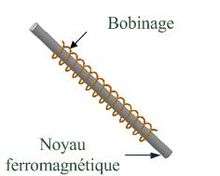Search coil
The search coil magnetometer, based on an inductive sensor (also known as inductive loop and inductive coil), is a magnetometer which measures the varying magnetic flux due to Lenz's law. An inductive sensor associated to a conditioning electronic constitute the search coil magnetometer (also known as induction magnetometer). It is a vector magnetometer which can measure one or more components of the magnetic field. A classical configuration uses three orthogonal inductive sensors. The search-coil magnetometer can measure magnetic field from mHz up to hundreds of MHz.
Principle
The inductive sensor is based on Faraday's law of induction. The temporal variation of the Magnetic Flux through a N turns circuit will induce a voltage which follows:
which can be expressed in a simpler way:
by assuming that the induced magnetic field B is homogeneous over a section S (the Magnetic flux will be expressed ).

The induced voltage ( ) may be increased several ways:
- increase the surface (S),
- increase the turn number (N),
- use a ferromagnetic core.
Search coil using a ferromagnetic core
When a coil is wound around a ferromagnetic core, that increases the sensitivity of the sensor thanks to the apparent permeability of the ferromagnetic core.
Apparent permeability
The magnetic amplification, known as apparent permeability , is the result of the magnetization of the ferromagnetic core response to an external magnetic field. The magnetization is reduced by the demagnetizing field.
where is the relative permeability, is the demagnetizing coefficient in the z direction.
The induced voltage will be written
The demagnetizing coefficient can easily be computed in the case of simple shapes (spheres and ellipsoids).
Applications
A search coil is used to measure eye movement using coils that are embedded into a tightly-fitting contact lens or a rubber ring that adheres to the eye. In animal studies, the search coil may be surgically implanted into the sclera of the eye. Alternating magnetic fields are generated by magnets positioned around the eye. Through electromagnetic induction, electric currents are generated in the search coils. The polarity and amplitude of the current generated varies with the direction and angular displacement of the eye. By measuring these values, the position of the eye can be determined. Search coils can be applied to one or both eyes.
In order to detect eye orientation in more than one dimension (e.g. up/down vs. left/right), multiple magnets oriented orthogonally to each other may be used. Each magnet generates a field using a different frequency, allowing the readings from the search coil to be analyzed by computer to determine displacement in multiple dimensions. Additionally, a second search coil can be added to measure torsional rotation.
- Education
A more crude search coil also called exploring coil is also used in laboratory experiments in schools to measure the magnetic field in a certain region of space. In this case the search coil consists of a simple wire coil or solenoid connected to a sensitive ammeter or galvanometer. The coil is placed in the magnetic field to be measured and quickly withdrawn to a region of space with a negligible magnetic field. As the search coil moves the magnetic flux linked with the coil changes. This induces a current in the coil which can be registered on the galvanometer. Since induced current is directly proportional to rate of change of flux linkage and assuming the coil is removed from the magnetic field very quickly, the maximum current measured by the ammeter is proportional to the magnetic field . The search coil can be calibrated by repeating this in a known magnetic field. A reference table shows open coil voltage versus magnetic field A/m (or teslas) or short current versus magnetic field.
Spacecraft with on board search coil magnetometers have been built for many decades to investigate EM waves in space plasma.
- Natural electromagnetic waves observations on Earth.
Many electromagnetic waves are observable on Earth. Let's quote Auroral research project (cf. Reference HAARP link).
References
- Pavel Ripka, Magnetic Sensors and Magnetometers, Artech House Publishers
- S. Tumanski, Induction Coil Sensors - a Review
- C. Coillot & P. Leroy, Induction Magnetometers: Principle, Modelling and ways of improvement, Intech Open Access Publisher
See also
- Waves (Juno) (Uses a magnetic search coil)